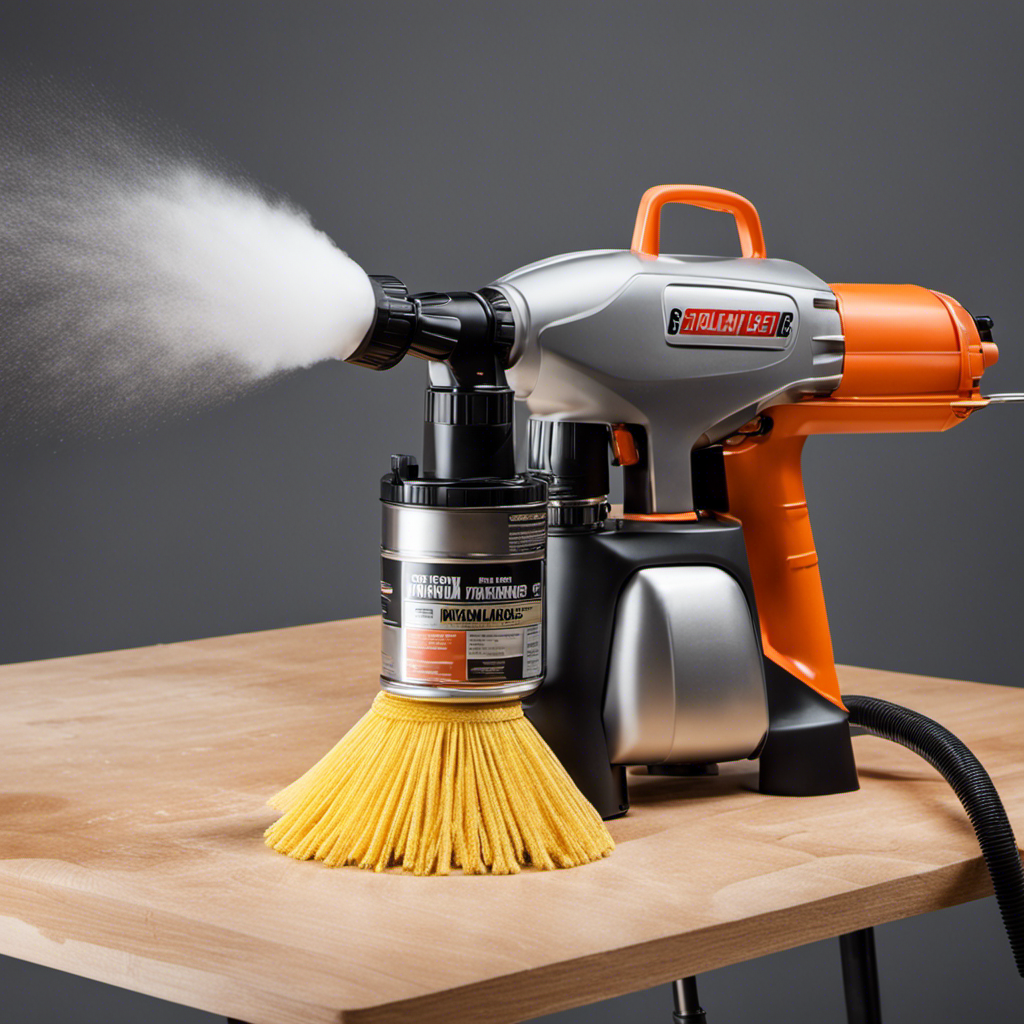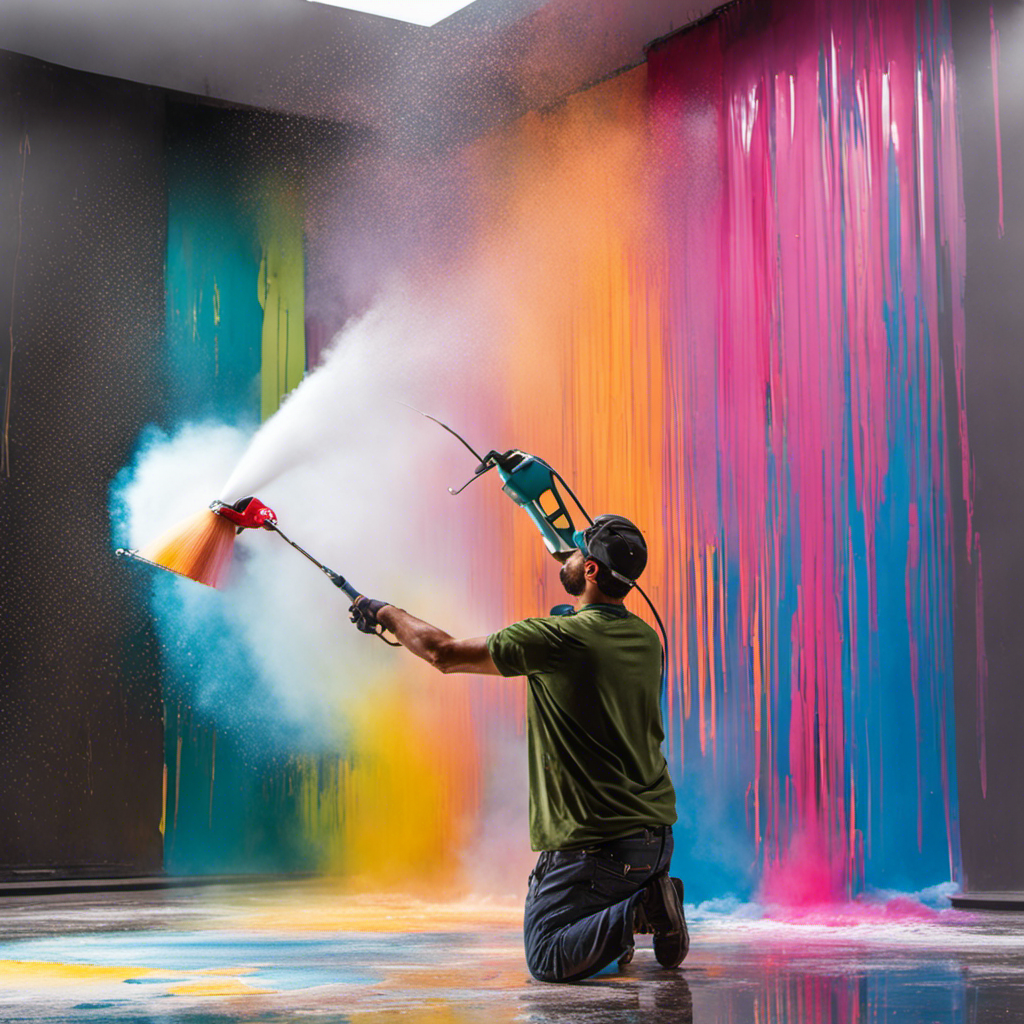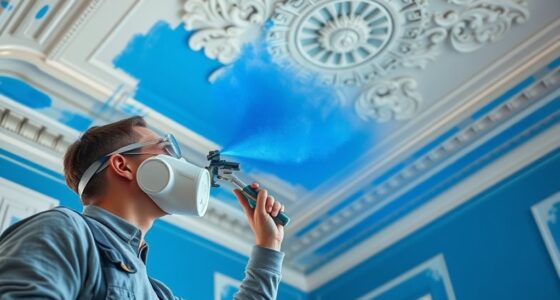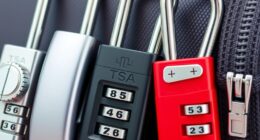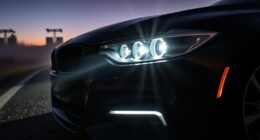In this article, we will guide you on the necessary steps and precautions required to properly clean your airless sprayer after using oil-based paints. It is important to follow the right techniques to guarantee a thorough cleaning.
By choosing the right cleaning solvent, disconnecting the sprayer from the power source, and wearing the necessary safety gear, you can protect yourself and maintain the longevity of your equipment.
Let’s dive into the detailed instructions for properly cleaning your airless sprayer after oil-based paint use.
Key Takeaways
- Choosing the right cleaning solvent is important for cleaning an airless sprayer that has been spraying oil-based paint.
- Disconnecting the sprayer from the power source and relieving pressure is necessary before cleaning.
- Removing excess paint from the sprayer is crucial to prevent contamination and ensure proper cleaning.
- Following the manufacturer’s instructions and wearing safety gear while using cleaning solutions is important for cleaning and maintaining the sprayer.
Key Takeaways and Safety Precautions
Choosing the right cleaning solvent and wearing safety gear are important steps to consider when properly cleaning an airless sprayer after using oil-based paint.
It is crucial to select a cleaning solvent that is specifically designed for oil-based paint, such as mineral spirits. This ensures that the solvent effectively breaks down the paint residue and prevents any damage to the sprayer.
Additionally, wearing safety gear, such as gloves and goggles, is essential when handling cleaning solutions to protect the skin and eyes from any potential hazards.
Gathering Materials and Preparing the Sprayer
Gathering the necessary materials for cleaning includes gathering a bucket or container, clean rags or paper towels, a cleaning solvent specifically designed for oil-based paint, and a small brush or toothbrush for scrubbing.
Choosing the right cleaning solvent is crucial for effectively cleaning an airless sprayer that has been spraying oil-based paint. It is important to use a cleaning solvent that is compatible with oil-based paint, such as mineral spirits.
Proper disposal regulations should also be followed when cleaning the sprayer. In California, it is necessary to dispose of solvents at a hazardous waste facility, seal and dispose of rags in a sealed bag, allow paint waste to dry before disposing of it in regular trash, and recycle empty paint cans at a recycling center.
Disconnecting and Relieving Pressure
Before cleaning, it is necessary to disconnect the airless sprayer from the power source and relieve any pressure in the system. This step is important to ensure safety and prevent accidents during the cleaning process.
Common mistakes to avoid during this step include forgetting to disconnect the power source, which can lead to electrical shocks, and failing to relieve pressure, which can result in paint or cleaning solution splattering.
To disconnect the sprayer, simply unplug it from the power outlet. To relieve pressure, follow these steps:
- Turn off the sprayer and release the trigger to stop the flow of paint.
- Hold a clean rag over the nozzle and slowly open the pressure release valve to release any remaining pressure.
- Wait for the pressure to fully release before proceeding with the cleaning process.
Removing the Spray Tip, Guard, and Filter
The user should remove the spray tip, guard, and filter from the airless sprayer to begin the cleaning process.
Cleaning the spray tip is of utmost importance to ensure proper functioning and avoid clogs. The spray tip is prone to paint buildup, which can affect the spray pattern and result in uneven application.
To clean the spray tip, the user should use a small brush or toothbrush to scrub away any residue. It is crucial to remove all traces of paint to prevent blockages and maintain optimal performance.
When it comes to cleaning solvents, there are alternatives to traditional options. Some users opt for environmentally friendly solvents or homemade solutions, such as vinegar or dish soap. These alternatives can be effective in removing paint residue while minimizing the use of harsh chemicals.
Pouring the Cleaning Solution Into the Reservoir
To begin the cleaning process, the user pours the cleaning solution into the reservoir of the airless sprayer.
When choosing the right cleaning solvent for an airless sprayer, it is important to consider the type of paint that was sprayed. For oil-based paint, a cleaning solvent specifically designed for oil-based paint, such as mineral spirits or a paint thinner, should be used. This ensures effective removal of oil-based paint residue.
Common mistakes to avoid when pouring the cleaning solution into the reservoir include overfilling or underfilling the reservoir. Overfilling can lead to spills and waste of cleaning solution, while underfilling may not provide enough solution for thorough cleaning.
It is crucial to follow the manufacturer’s instructions and pour the appropriate amount of cleaning solution into the reservoir for optimal cleaning results.
Running the Cleaning Solution Through the System
Once the cleaning solution is poured into the reservoir, the user runs it through the system to effectively flush out any remaining paint particles and residue. It is important to choose a cleaning solution that is effective in breaking down oil-based paint residue, such as mineral spirits or paint thinner.
The cleaning solution should be allowed to circulate through the sprayer for a few minutes to ensure thorough cleaning. During this process, the user should follow the manufacturer’s instructions and wear appropriate safety gear to protect themselves from any potential hazards.
After running the cleaning solution through the system, it is crucial to properly dispose of the cleaning materials. This can be done by taking the solvents to a hazardous waste facility, sealing and disposing of rags in a sealed bag, allowing paint waste to dry before disposing of it in regular trash, and recycling empty paint cans at a recycling center.
Following these proper disposal methods is essential to protect the environment and comply with waste disposal regulations.
Tilt and Drain Excess Paint
After removing the spray tip, guard, and filter, the user can tilt the sprayer over a bucket to allow the excess paint to drain out. This step is crucial in preventing paint contamination and maintaining the sprayer’s performance.
Here are some discussion ideas about the importance of proper paint disposal and the environmental impact, as well as tips for preventing paint contamination and maintaining the sprayer’s performance:
- Proper paint disposal is essential to protect the environment and comply with waste disposal regulations.
- Improper disposal can lead to water pollution, soil contamination, and harm to wildlife.
- Avoid pouring paint down the drain or into the trash; instead, take it to a hazardous waste facility.
- To prevent paint contamination, always strain the paint before pouring it into the sprayer’s reservoir.
- Regularly clean and maintain the sprayer, including the filters and nozzles, to prevent clogs and ensure optimal performance.
Flushing the Sprayer With a Cleaning Solution
The user effectively flushes the sprayer with a cleaning solution to remove any remaining paint particles and residue. When choosing a cleaning solution, it is important to consider options such as mineral spirits or paint thinner, as they are specifically designed to break down oil-based paint residue.
Following the manufacturer’s instructions and wearing appropriate safety gear is crucial while using cleaning solutions. After removing excess paint from the sprayer, the user can proceed to flush the system with the chosen cleaning solution. This step ensures that all components, including the nozzle, filters, and hoses, are thoroughly cleaned to prevent clogs and ensure proper functioning.
Proper disposal of cleaning materials is equally important. It is necessary to comply with waste disposal regulations, such as those in California, by disposing of solvents at a hazardous waste facility, sealing and disposing of rags in a sealed bag, allowing paint waste to dry before disposing of it in regular trash, and recycling empty paint cans at a recycling center.
Cleaning the Nozzle, Filters, and Hoses
To clean the nozzle, filters, and hoses, the user should disassemble each component and thoroughly clean them with a brush and a cleaning solution. Here are some cleaning techniques and maintenance tips to keep in mind:
- Start by disconnecting the sprayer from the power source and relieving pressure.
- Remove the nozzle, filters, and hoses and clean them separately using a brush and a cleaning solution.
- Ensure all paint residue and clogs are removed from the components.
- Use a cleaning solution specifically designed for oil-based paint to break down any stubborn residue.
- Follow the manufacturer’s instructions and wear appropriate safety gear while cleaning.
By properly cleaning the nozzle, filters, and hoses, you can prevent clogs and ensure the proper functioning of your airless sprayer.
Regular maintenance and cleaning will help prolong the lifespan of your equipment and ensure optimal performance.
Disassembling the Spray Gun
Disconnecting the spray gun from the airless sprayer and removing its components is necessary for disassembling and cleaning it thoroughly.
To start, ensure the sprayer is disconnected from the power source and pressure is relieved.
Next, remove the nozzle and guard from the spray gun and clean them with a brush and cleaning solution.
Disassemble the gun by removing the needle, fluid nozzle, and air cap, cleaning each component separately.
Use a soft cloth or brush to remove any paint residue from the gun body.
Reassemble the spray gun carefully, ensuring a snug fit.
Following these cleaning techniques will help maintain the spray gun’s functionality.
Troubleshooting tip: If the gun is not spraying properly after cleaning, check for clogs or build-up in the nozzle, filters, or hoses, and clean them accordingly.
Cleaning the Nozzle and Guard
After disassembling the spray gun, the next step in properly cleaning your airless sprayer after using oil-based paint is to clean the nozzle and guard. This cleaning technique is crucial for maintaining the sprayer’s performance and preventing clogs.
Here are some common mistakes to avoid when cleaning the nozzle and guard:
- Neglecting to remove the nozzle and guard before cleaning: It’s important to remove these components to ensure thorough cleaning and prevent paint residue buildup.
- Using a brush with bristles that are too stiff: Opt for a soft brush or toothbrush to avoid damaging the delicate parts of the nozzle and guard.
- Not using an appropriate cleaning solution: Choose a cleaning solvent recommended by the manufacturer to effectively break down oil-based paint residue.
- Rushing the cleaning process: Take your time to clean every nook and cranny of the nozzle and guard to ensure proper functioning of the sprayer.
- Forgetting to rinse after cleaning: After using a cleaning solution, rinse the nozzle and guard with clean water to remove any remaining residue.
Cleaning the Needle, Fluid Nozzle, and Air Cap
The next step in maintaining the performance of the airless sprayer involves cleaning the needle, fluid nozzle, and air cap. Proper cleaning techniques are essential for ensuring the longevity and effectiveness of these components.
To clean the needle, fluid nozzle, and air cap, start by removing them from the spray gun. Use a cleaning solution, such as mineral spirits or paint thinner, to break down any paint residue. Scrub the components thoroughly with a brush or toothbrush to remove any stubborn debris.
Rinse them with clean water to remove any remaining cleaning solution. Make sure to dry them completely before reassembling the spray gun.
Regularly cleaning these components will prevent clogs and ensure smooth and consistent spraying. Following these maintenance tips will help keep your airless sprayer in optimal condition.
Removing Paint Residue From the Gun Body
To effectively remove paint residue from the gun body, one must scrub it thoroughly with a brush or cloth soaked in a cleaning solution such as mineral spirits or paint thinner. This process is essential for preventing contamination and maintaining the proper functioning of the spray gun.
Here are five important steps to follow when removing paint residue from the gun body:
- Start by disassembling the spray gun and removing the nozzle, guard, and other components.
- Use a brush or cloth soaked in a cleaning solution to scrub the gun body, focusing on areas with visible paint residue.
- Pay attention to hard-to-reach areas and corners to ensure all paint residue is removed.
- Rinse the gun body with clean water to remove any remaining cleaning solution or paint residue.
- Allow the gun body to air dry completely before reassembling and storing it.
Drying, Reassembling, and Proper Disposal
Once the components are thoroughly dried, they can be carefully reassembled, ensuring a proper fit. Reassembling the airless sprayer correctly is crucial to its optimal performance.
Start by placing the nozzle, guard, and filter back in their respective positions. Make sure they are securely attached to prevent any leaks or malfunctions during operation. Follow the manufacturer’s instructions to ensure proper reassembly.
After reassembling the sprayer, it is important to consider proper disposal methods for any cleaning materials used. Solvents and cleaning solutions should be disposed of at a hazardous waste facility. Rags used during the cleaning process should be sealed in a bag to prevent any leaks and then disposed of. Paint waste should be allowed to dry before disposing of it in regular trash.
Always follow local waste management guidelines and regulations to protect the environment and avoid legal consequences.
Frequently Asked Questions
How Often Should I Clean My Airless Sprayer After Using Oil-Based Paint?
It is important to clean an airless sprayer after using oil-based paint to prevent clogs and ensure proper functioning.
The spray tip should be replaced when it becomes worn or damaged, or as recommended by the manufacturer.
The best cleaning solutions for oil-based paint residue include mineral spirits or paint thinner.
Cleaning the sprayer regularly helps maintain its performance and prolong its lifespan.
Following the manufacturer’s instructions and guidelines for cleaning and maintenance is crucial for optimal results.
Can I Use Water-Based Cleaning Solutions to Clean an Airless Sprayer That Has Been Spraying Oil-Based Paint?
Water-based cleaning solutions are not recommended for cleaning an airless sprayer that has been used to spray oil-based paint. This is because oil-based paint requires a solvent that can effectively break down its residue. Using a water-based cleaning solution may not be as effective and could leave behind paint particles or residue that could clog the sprayer or affect its performance.
It is best to use a cleaning solvent specifically designed for oil-based paint to ensure proper cleaning and maintenance of the airless sprayer.
Is It Necessary to Wear Safety Gear While Cleaning the Sprayer?
Wearing safety gear while cleaning the sprayer is crucial. It ensures the protection of the individual from potential hazards associated with cleaning solutions and residue.
Proper maintenance for airless sprayers is of utmost importance, and wearing safety gear is an integral part of that maintenance process.
When choosing the right cleaning solution for your airless sprayer, consider using solvents specifically designed for oil-based paint. These solvents effectively break down paint residue and ensure a thorough cleaning of the sprayer.
What Should I Do if the Cleaning Solution Doesn’t Remove All the Paint Residue From the Sprayer?
If the cleaning solution doesn’t remove all the paint residue from the sprayer, there are a few options to consider.
First, try using a different cleaning solvent specifically designed for oil-based paint. If that doesn’t work, you can try using alternative cleaning methods such as scrubbing with a brush or toothbrush, or soaking the affected parts in the cleaning solution for a longer period of time.
If all else fails, it may be necessary to seek the assistance of professional cleaning services to ensure a thorough cleaning.
Can I Reuse the Cleaning Solution or Do I Need to Dispose of It After Cleaning the Sprayer?
The cleaning solution used to clean the airless sprayer after oil-based paint use can be reused in certain cases. However, it is important to note that the cleaning solution may become less effective over time as it accumulates paint residue.
If the cleaning solution doesn’t remove all the paint residue, alternative cleaning methods such as using a stronger solvent or soaking the parts overnight may be necessary.
Ultimately, it is recommended to dispose of the cleaning solution properly to ensure optimal cleaning results.
Conclusion
In conclusion, properly cleaning an airless sprayer after using oil-based paint is essential for maintaining its performance and prolonging its lifespan. By following the outlined steps and safety precautions, users can ensure a thorough cleaning process that eliminates paint residue and prevents contamination.
Remember, cleaning the sprayer is like giving it a rejuvenating spa treatment, removing all traces of paint and leaving it fresh and ready for the next project. So, take the time to clean your airless sprayer diligently, and you’ll reap the benefits of a well-maintained and efficient tool.
Franz came aboard the Paint Sprayer Zone team with a background in both journalism and home renovation. His articulate writing style, combined with a passion for DIY projects, makes him an invaluable asset. Franz has a knack for breaking down technical jargon into easy-to-understand content, ensuring that even the most novice of readers can grasp the complexities of paint sprayers.
